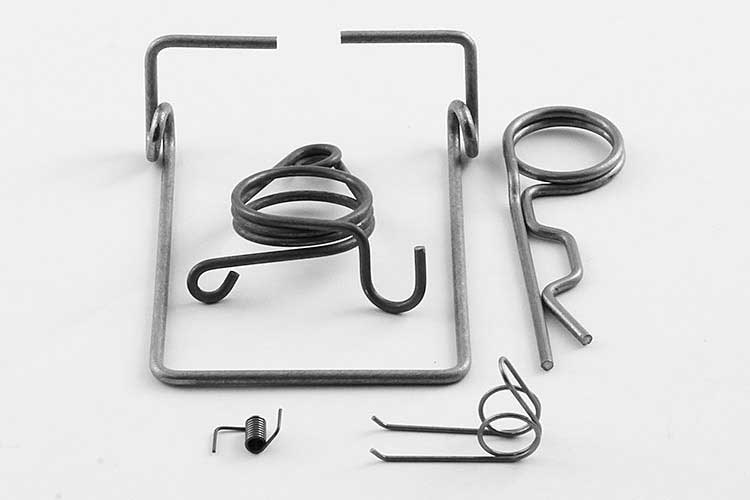Get unique, complex parts easily. No matter your requirements, Chaoyi Spring creates hard-to-produce coil springs and wire forms.
Let us help you create the custom wire form you need, from S-hooks and J-hooks to utility hooks and more.
We work closely with customers across a wide range of industries, helping them design and manufacture made-to-order parts.
Why choose Chaoyi Spring? We prioritize customer-focused collaboration, modern equipment and the latest technology to make your parts per print.
Find the information and guidance you need, from measuring a spring to learning about materials, placing an order and much more.
Torsion spring winding bars are indispensable tools in the manufacturing of precision springs. These bars, often made from hardened steel, provide the crucial support and guidance needed to wind torsion


Torsion spring winding bars are indispensable tools in the manufacturing of precision springs. These bars, often made from hardened steel, provide the crucial support and guidance needed to wind torsion springs with the desired shape and properties. This article will delve into the intricacies of torsion spring winding bars, exploring their design, materials, and applications. We will also examine the factors that contribute to their accuracy and efficiency, highlighting their importance in ensuring the optimal performance of torsion springs.

Torsion springs, known for their ability to store and release rotational energy, are ubiquitous in various industries. From automotive components to medical devices, these springs play a vital role in countless applications. The precision and reliability of these springs depend heavily on the quality of the winding process, which is where torsion spring winding bars step in.
These bars serve as the backbone of the winding operation, providing the structural support and precise guidance needed to shape the spring wire into its intended form. The bar's design dictates the spring's geometry, with variations in the bar's diameter, length, and shape leading to distinct spring characteristics.
Torsion spring winding bars are typically composed of high-quality hardened steel, a choice that ensures durability and dimensional stability. The bar's surface is often ground to a smooth finish, minimizing friction and ensuring the smooth passage of the spring wire during winding.
The design of a torsion spring winding bar is critical to the success of the winding process. Key considerations include:
The material chosen for torsion spring winding bars plays a significant role in their performance. Hardened steel is the preferred choice for most applications due to its strength, durability, and resistance to wear. However, other materials like stainless steel or aluminum may be used for specific requirements.
Hardened steel bars offer excellent dimensional stability, ensuring that the spring's geometry remains consistent throughout the winding process. Stainless steel, known for its corrosion resistance, may be preferred in environments where corrosion is a concern. Aluminum, due to its lighter weight, may be chosen for applications where weight optimization is crucial.
The process of winding torsion springs involves feeding the spring wire onto the torsion spring winding bar. The bar's smooth surface and precise design ensure that the wire is wound consistently, resulting in a spring with the desired shape and properties. The winding process requires specialized machinery that controls the tension, speed, and direction of the wire, all of which contribute to the final spring's characteristics.
The precision of the winding process is paramount to the spring's performance. Inconsistent winding can lead to irregularities in the spring's coils, resulting in inconsistent spring force, reduced fatigue life, and even premature failure. Therefore, the quality and design of the torsion spring winding bar are essential for maintaining the integrity of the spring throughout its lifespan.
Torsion springs are widely used across diverse industries, including:
Selecting the appropriate torsion spring winding bar for your specific application requires careful consideration of several factors:
Torsion spring winding bars are critical components in the precision manufacturing of torsion springs. Their design, materials, and winding process significantly impact the quality, performance, and durability of the final product. By carefully selecting the right winding bar for your specific application, you can ensure that your torsion springs meet the highest standards of accuracy, reliability, and performance.
In conclusion, torsion spring winding bars are vital tools in the world of precision manufacturing. Their ability to guide and shape spring wire with meticulous precision ensures that torsion springs meet the demanding standards of modern industries. By understanding the key considerations involved in selecting and utilizing these bars, manufacturers can optimize their spring production processes, leading to higher-quality products and greater overall efficiency.
Browse some of the custom wire forms and springs that we manufacture. Don’t see what you need? We specialize in made-to-order products that meet your application requirements.
Visit Our GalleryNeed a custom wire form or coil spring? We make it work. Fill out the contact form and a representative will respond within 1 business day. If you have a PDF or CAD file, you can submit to request a quote.